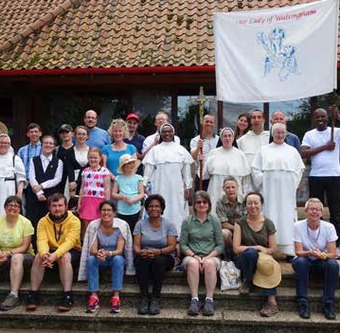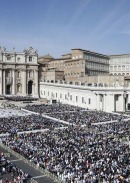
A Walking Pilgrimage 2019
Article:
06.11.19
A Walking Pilgrimage 2019
Sr Carino Hodder tells the story of a 20-mile-a-day walk to England’s Nazareth
A line of thirty-five pilgrims - including three habited Dominicans - singing, praying the Rosary and carrying a processional cross as they walk might strike one as an unexpected sight amongst the country lanes of Norfolk. But in fact, the St John Paul II walking pilgrimage to Walsingham, run by the Dominican Sisters of St Joseph, is a regular occurrence - and, for we sisters who run it, an integral part of our mission of evangelisation. After all, when beginning a difficult and seemingly impossible task, the wisest thing to do is to get help from someone who has done it before; and so when it comes to evangelizing England and Wales, what better way to go about it than to ask for help from the first person to hear and pass on the Good News: Mary, the Mother of God?
Pilgrims, pasta and blister-plasters
To this end, every August for the past twelve years a group of Dominican sisters have travelled up from our priory in the South of England, laden with sleeping bags, blister plasters and the constitutive elements of our Prioress’ renowned cheesy pasta, and walked fifty miles over three days from Bury St Edmunds to the Shrine of Our Lady of Walsingham. Over the years the pilgrimage group we bring with us has included six-year-olds and eighty-year-olds, cradle Catholics and recent converts, people from Africa or Central Europe and people who have never left England. But one thing about our pilgrims never changes: by the end of the pilgrimage, what began as an entirely implausible collection of strangers has become a tightly-knit group of friends bound together by love, camaraderie andpenance. The intentions that each of us lays at the feet of Our Lady once we arrive in Walsingham are all different, but the joy and fulfilment we feel on reaching her Shrine is exactly the same.
Goal
The Catholic Shrine of Our Lady of Walsingham, the goal and finality of our pilgrimage, is an increasingly important part of English Catholic life. Even after its destruction at the Reformation the smouldering light of faith in Walsingham never quite went out, and over the past few years has grown into an ever-stronger flame as we approach the Rededication of England as Our Lady’s Dowry. It seems that, more and more, English Catholics are recognising the significance of Walsingham in our lives of faith: as an integral part not only of our Catholic past but also of our Catholic present and future, as we continue to pray that the truth about the human person might be rediscovered in our public discourse, that the vulnerable and needy in our society be protected, and that our country might someday return to the Church.
Bury St Edmunds
This year’s pilgrimage began as ever in the Catholic church of St Edmund the Great in Bury St Edmunds, with Mass, Benediction and Evening Prayer. The following morning we travelled to the village of Brandon, where we were given a warm welcome by the parish community of St Thomas of Canterbury Catholic Church: spiritual nourishment in the form of Mass, celebrated by our chaplain, and unspiritual but no less welcome nourishment in the form of breakfast. Our stop in Brandon, with the wonderful hospitality we invariably receive there, always strikes a defining note of our pilgrimage: each year we are bolstered and encouraged by the support of the parish communities, both Anglican and Catholic, which we encounter along our way.
Norfolk countryside
From Brandon we walked twenty miles through the Norfolk countryside to Swaffham, where we were to stay overnight in a school currently owned by a thriving congregation of Sacred Heart Sisters. There we prayed Evening Prayer and, perhaps against our better judgement, played badminton in the school gym. Another twenty miles the next day took us to Castle Acre, where we were kindly given the use of the beautiful Anglican church of St James the Great for Mass, and then on to the village of West Raynham. There our pilgrimage reached its ecumenical peak as, after a wonderful barbecue in the garden of one of the village families, we joined with the local Anglican priest and his flock to pray Night Prayer among the village’s picturesque church ruins.
The Shrine
The next morning, we walked - or in some cases hobbled - a final ten miles into the Catholic Shrine of Our Lady of Walsingham, and, after presenting our petitions to Our Lady in the Slipper Chapel, joined the midday Mass at the Shrine and walked the Holy Mile together. We concluded the pilgrimage with Evening Prayer, Adoration and Benediction in the parish church.
A pilgrimage is, in many ways, the Church in microcosm, and everything we experience in our lives of faith we also experienced in concentrated form on our journey to Walsingham. Ultimately there is prayer: the Divine Office and regular rosaries, together with daily Mass and Confession thanks to our chaplain, Fr Dominique-Benoit Jean-Luc OP of the Dominican Province of Toulouse, assisted by our long-standing and possibly long-suffering sacristan Richard. There is also fellowship: we journey not alone but within a community that reflects our sacramental communion within the Body of Christ. And there is that most misunderstood of Christian experiences, redemptive suffering: the suffering by which we are purged of the impediment of our selfishness and enabled to grow in selfless love.
The Church
But our pilgrim journey is an image of the Church pre-eminently because it is just that - a journey. We are moving towards a goal. In this sense, the great lesson of pilgrimage is not a lesson of faith, but of hope - the theological virtue, supernaturally infused at Baptism, by which we arespurred to move towards our ultimate goal and finality: not Walsingham, wonderful as it is, but beatific union with God. Normally in our Christian lives ‘movement’ is a purely poetic term, a descriptive analogy for conversion and spiritual growth, but on pilgrimage, trudging determinedly across fields and roads to our journey’s end, the idea of hopeful movement becomes edifyingly and immediately literal.
This is why the talks that we sisters gave on this year’s pilgrimage focused on that theological virtue of hope and what we could learn about it from our experience as pilgrims. We explored the virtue of hope through the prism of various books of the Bible: unexpected corners of the Old Testament such as Job and Ecclesiastes, and in the examples of saints such as Peter and Our Lady, each revealing a different facet of hope. As members of a preaching Order, we feel it is an integral part of our pilgrimage to offer theological input along the way - or, to put it more bluntly, Dominicans can’t help but talk a lot, even when we’re walking.
And next year
But it is never the work of the sisters - whether that is writing talks, cooking meals, or registering pilgrims - which makes the St John Paul II such a success. It is instead the pilgrims themselves, with their enthusiasm and resilience, their prayer, their support and encouragement for one another, their willingness to muck in and help out when setbacks or outright disaster seems to be looming. We are very grateful to all our pilgrims, to our Safety Officer Wayne Culver and his son Dan for once again getting us to Walsingham healthy, cheerful and more or less in one piece, as well as to the various Catholic and Anglican parishes who supported us along our way.
The next St John Paul II walking pilgrimage to Walsingham will take place from Thursday 30th July – Sunday 2nd August 2020. If you are interested in joining us, please contact [email protected] for further details, or visit https://dominicansistersofstjoseph.org/JPII.
Notes:
Sister Carino is a member of the Dominican Sisters of St Joseph at St Dominic's Priory Lymington, Hants.





